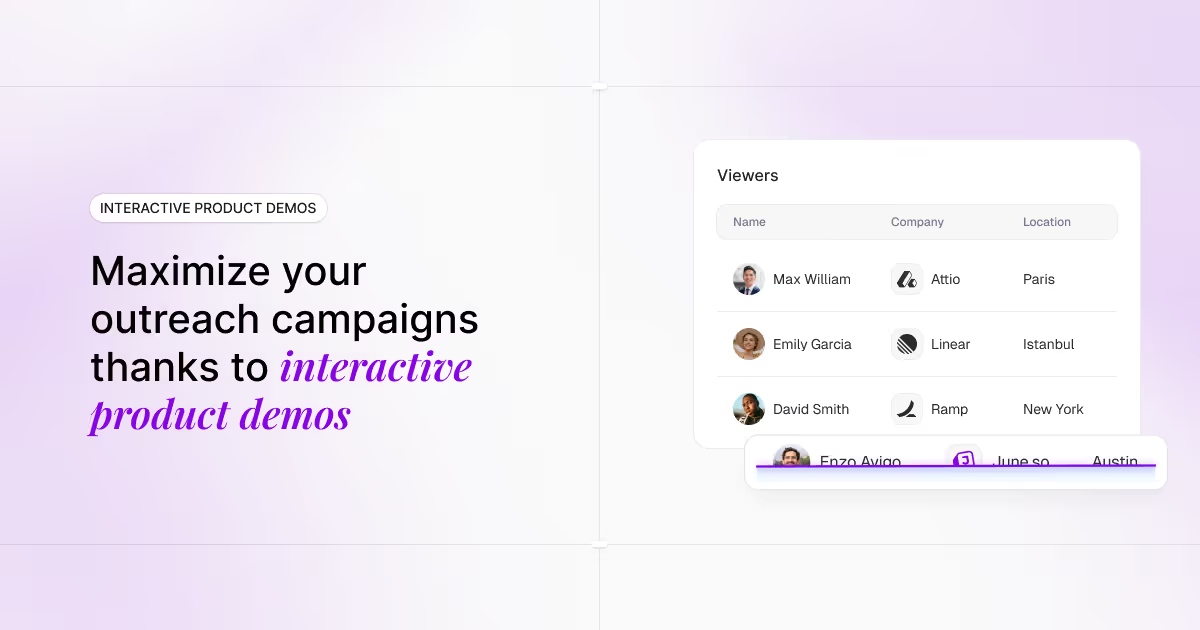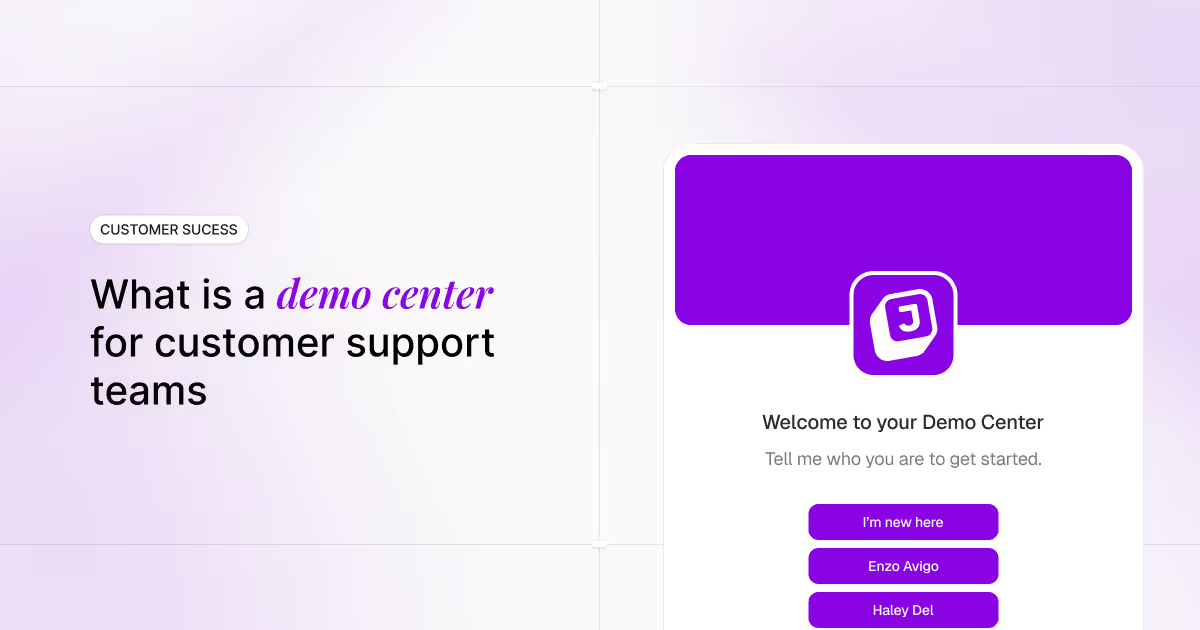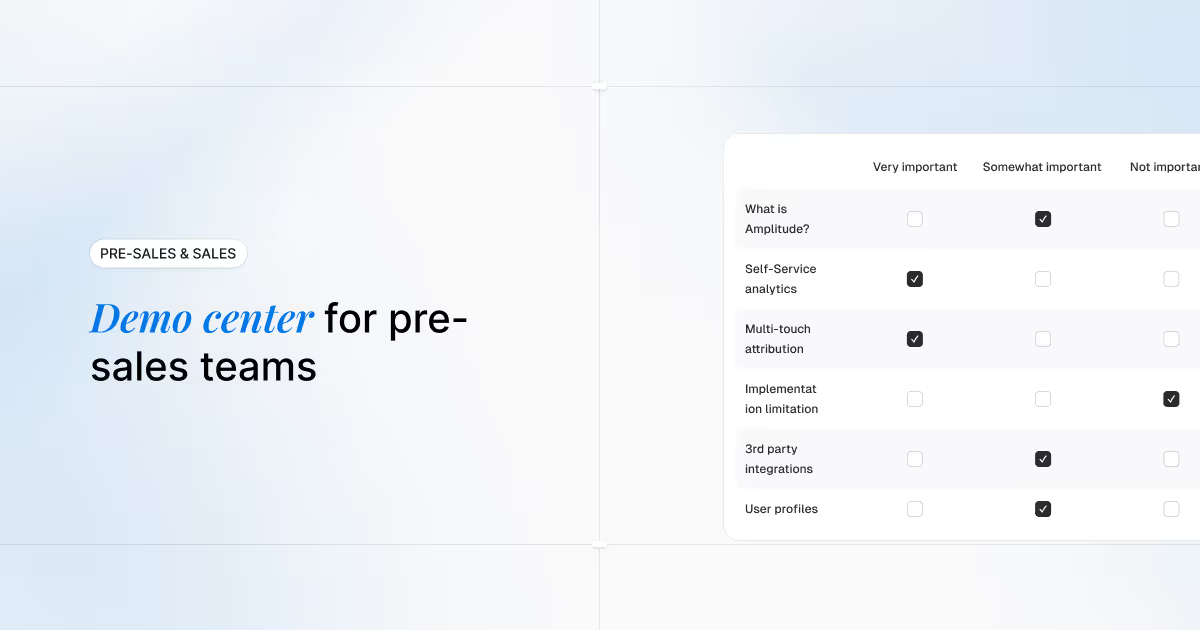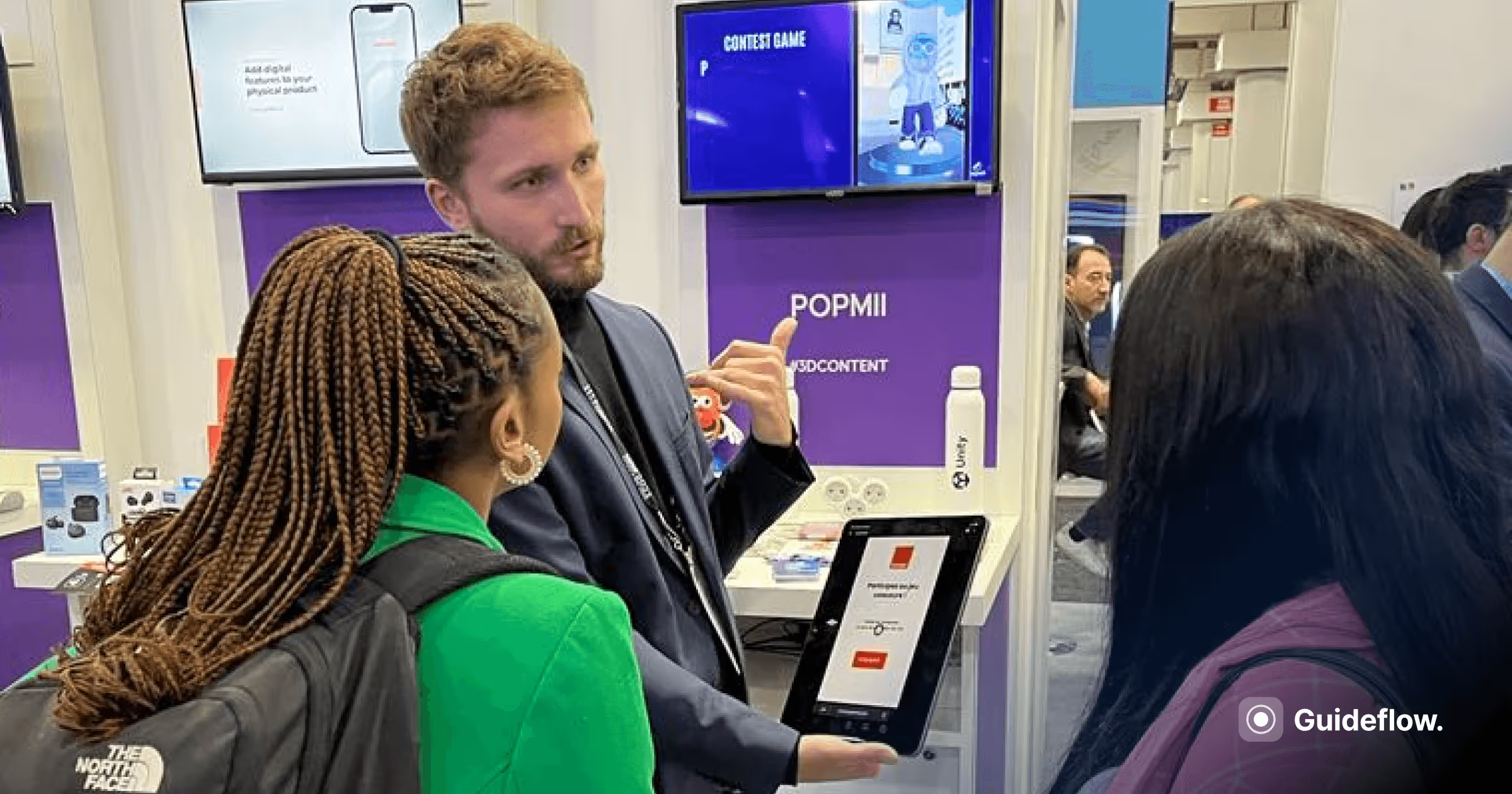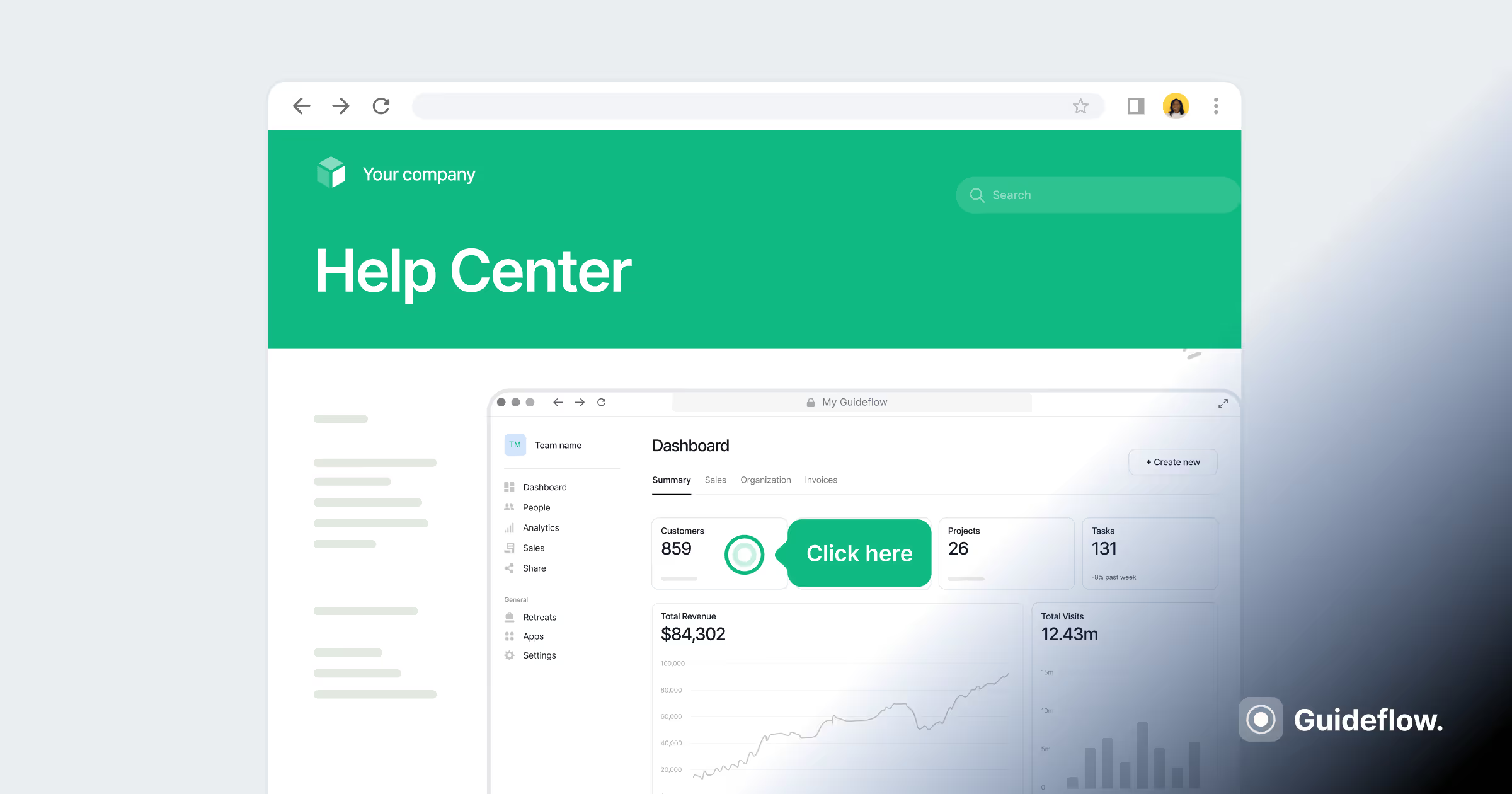The complete guide to sandbox demos for presales teams
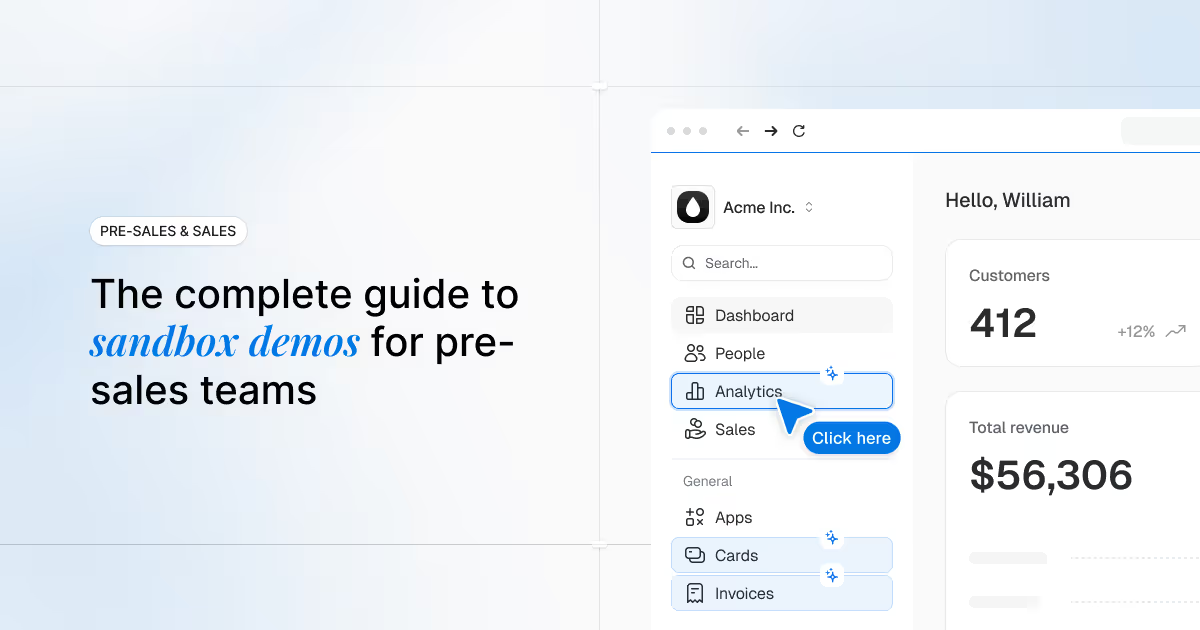


Picture this: It's 2 PM on a Tuesday, and you're about to deliver your fourth product demo of the day. The prospect joins the call, but your demo environment crashes. Again. You spend the first ten minutes troubleshooting while watching your carefully scheduled meeting slip away. Meanwhile, three more demo requests pile up in your inbox, and your AE is asking if you can "quickly hop on a call" for what should be a straightforward technical validation.
Sound familiar? You're drowning in demo requests, spending 15-20 hours per week on repetitive product walk-throughs that could be automated. Your calendar is packed with basic "show me how it works" meetings while complex, strategic opportunities wait for your attention.
Here's the reality: 60-70% of your live demos cover identical ground. Basic product overviews, standard workflow demonstrations, and feature comparisons that prospects could explore on their own if they had the right tools.
What if you could automate demo production and empower your sales team to validate technical fit independently before requesting your time? What if you could gain more time to focus on complex integration discussions and strategic solution design that truly require your expertise?
Enter sandbox demos: interactive environments that handle routine technical validation automatically, freeing you to work on deals that matter.
What is a sandbox demo?
Sandbox demos are interactive, clickable replicas of your product that your sales team can explore freely with prospects during live demo calls without requiring logins, live environments, or technical setup. They combine realistic product interfaces in safe, isolated environments that simulate authentic user experiences while eliminating technical risks and data security concerns.
Unlike traditional screen-sharing demos where you control every click and explain every feature, sandbox environments allow prospects to navigate the product freely alongside the sales rep during a live demo call. Prospects can click buttons, explore workflows, input data, and experience realistic scenarios that demonstrate your product's value in action - just as if they were using your actual software.
For presales professionals, sandbox demos can serve as the first line of technical validation. They handle the "show me how it works" requests that consume hours of your day, while generating qualified interest for the complex scenarios where your expertise truly matters.
Here's what sets them apart from everything else you've tried: they function as an independent version of your authentic product. Prospects can explore features specific to their use case, revisit relevant sections, and share the experience with stakeholders, all without scheduling additional meetings with presales and blocking your performance.
Key characteristics
- Always available - Works 24/7 across all time zones without your involvement
- Self-service technical validation - Prospects qualify themselves before requesting your time
- Exploratory by design, enabling unrestricted navigation and discovery
- Reusable and scalable across different teams, marketing campaigns, and customer lifecycle stages
- Ultra realistic with authentic user interfaces and interaction patterns
- Risk-free without exposing production systems or sensitive data
- Trackable with comprehensive engagement analytics
Sandbox vs. interactive demos: understanding the key differences
You might wonder how these differ from other sandbox demo formats you've seen. Understanding these distinctions helps you choose the right approach for different presales scenarios.
Choose sandbox demos for:
- Technical qualification before investing live demo time
- Complex product validation requiring hands-on exploration
- Multi-stakeholder evaluation where different roles need different access
- Time zone challenges where immediate access is essential
- High-volume demo periods when your calendar is overwhelmed
Choose interactive demos for:
- Initial product introduction where prospects need structured education
- Simple feature showcase with clear, linear messaging
- Marketing-led campaigns focused on awareness and interest generation
- Sales team enablement where AEs need specific talking points
- Social media and content marketing requiring compelling visuals
Why sandbox demos are game-changers for presales teams
You operate at the front lines of technical sales, where your expertise directly impacts deal velocity and win rates. Sandbox demo solve the operational challenges that consume your time while amplifying the strategic value you bring to every opportunity.
Eliminating the qualification time sink
Most of your demo requests come from unqualified prospects who haven't done basic research. They book your time for generic product overviews that could be handled through self-serve exploration.
Sandbox demos act as your qualification filter. Prospects who engage deeply with sandbox demos and request follow-up meetings arrive with specific questions, clear use cases, and genuine buying intent. Instead of spending 30 minutes explaining basic functionality, you can dive straight into their technical requirements and integration challenges.
Companies using sansboxes see conversion rates jump from 3.05% to 24.35%. For presales teams, this means spending time only with genuinely interested prospects who have already demonstrated engagement with your solution.
Solving the scalability crisis during peak periods
Product launches, conference seasons, and end-of-quarter pushes create demo request avalanches that overwhelm even the largest presales teams. Traditional approaches force you to choose between response speed and demo quality, often resulting in both suffering.
Sandbox demos eliminate these capacity constraints. Prospects get immediate technical validation without calendar coordination. Your response time drops from days to minutes, while maintaining consistent demo quality regardless of demand volume.
Data from enterprise SaaS companies shows average sales cycles reduce from 33 to 27 days when prospects access interactive demos before live meetings. The asynchronous nature means prospects in different time zones don't wait for your availability, maintaining momentum throughout their buying process.
Enabling strategic focus on high-value opportunities
Every hour you spend on basic product walk-throughs is an hour unavailable for complex technical architecture discussions, custom integration planning, and strategic solution design that actually require your expertise.
Sandbox demos handle routine technical validation automatically, freeing you to focus on opportunities where your knowledge creates real competitive advantage. You become a technical consultant rather than a product narrator, working on deals that leverage your full capabilities.
Improving deal quality through better technical validation
Prospects who explore sandbox demos before live meetings arrive with deeper product understanding and more sophisticated questions. This preparation leads to more productive conversations focused on specific technical challenges rather than general product education.
The data reveals improved POC success rates (45% higher) and better technical validation completion (38% improvement) when prospects can thoroughly explore functionality before committing to formal evaluation periods. You get better-qualified POC candidates and more successful technical validation processes.
Key features and benefits that make sandbox demos so powerful for presales teams
Modern sandbox demo platforms, such as Guideflow, offer capabilities designed specifically for presales efficiency, measurement, and technical validation quality.
Zero-overhead technical replication
HTML-based capture technology creates pixel-perfect product copies with full interactive capabilities preserved, no environment setup required.
Why it matters
You can create authentic technical validation experiences in minutes without involving engineering resources or maintaining separate demo environments that crash during critical meetings.
Always-on availability across time zones
Sandbox demos work 24/7 without your involvement, providing immediate technical validation regardless of geography or schedule constraints.
Why it matters
You eliminate scheduling bottlenecks that slow deal progression, especially valuable for international prospects and during high-demand periods when your calendar fills up weeks in advance.
Behavioral intelligence for better prospect qualification
Comprehensive tracking captures every interaction, showing which features prospects explored, how long they engaged, and where they encountered questions or obstacles.
Why it matters
You arrive at live meetings knowing exactly what interests each prospect most, allowing you to focus conversations on their specific technical requirements rather than generic product overviews.
Self-service technical validation at scale
Prospects can validate technical fit, explore integration capabilities, and assess security features independently before requesting specialized presales support.
Why it matters
You spend time only with prospects who have demonstrated genuine technical interest and specific evaluation criteria, improving your conversion rates and time utilization.
Seamless internal collaboration and sales enablement
Account executives can showcase technical capabilities independently using sandbox demos, reducing their dependency on presales resources for basic product demonstrations.
Why it matters
You get pulled into fewer low-priority opportunities while maintaining consistent technical messaging across all prospect interactions, improving overall deal coverage.
Instant updates and version control
Real-time content modification allows immediate sandbox demo updates without requiring new captures or rebuilding entire environments.
Why it matters
You maintain technical accuracy during product releases and feature updates while preserving all prospect engagement history and analytics data.
Where and when to use sandbox demos in presales
Strategic deployment requires understanding which presales scenarios benefit most from interactive technical validation and how to integrate them effectively into existing sales processes.
Pre-meeting technical qualification
Deploy sandbox demos before scheduling live technical validation meetings. This approach filters out prospects who aren't serious about evaluation while ensuring qualified meetings focus on specific technical requirements rather than basic product education.
Best practices
- Send interactive demos with meeting confirmation emails
- Include specific exploration goals related to their use case
- Track engagement depth to prioritize meeting preparation
- Use behavioral data to customize live demo focus areas
During peak demand periods
Use sandbox demos to maintain response quality when demo requests exceed your capacity. Product launches, conference follow-ups, and seasonal buying periods often create unsustainable demo volumes.
Best practices
- Automatically send sandbox demos for initial technical validation
- Prioritize live meetings based on interactive engagement depth
- Create dedicated environments for specific campaign scenarios
- Monitor completion rates to identify bottlenecks in self-service flows
Multi-stakeholder technical evaluation
Enable different stakeholders within target accounts to explore relevant functionality without requiring separate live demonstrations for each role. IT administrators, end users, and executives can access appropriate technical content independently.
Best practices
- Create role-specific sandbox experiences for different stakeholders
- Track engagement across all account contacts for complete visibility
- Coordinate live follow-up based on collective exploration patterns
- Share stakeholder engagement data with account teams for strategic planning
RFP and formal evaluation processes
Submit sandboxes as part of technical responses, allowing evaluation committees to assess capabilities thoroughly without requiring environment setup or scheduling coordination.
Best practices
- Customize sandbox content to address specific RFP requirements
- Include realistic data scenarios relevant to their industry context
- Provide clear navigation guidance for non-technical evaluators
- Track usage patterns to inform follow-up technical discussions
International and remote prospect engagement
Address time zone challenges and travel limitations by providing comprehensive technical validation that works independently of geographic constraints.
Best practices
- Ensure sandbox environments work across different devices and browsers
- Include clear instructions for prospects unfamiliar with interactive demos
- Provide multiple language options when targeting international markets
- Schedule follow-up meetings based on optimal engagement timing data
Partner and channel enablement
Enable channel partners to demonstrate technical capabilities without requiring direct presales support, extending your technical validation reach without proportional resource increases.
Best practices
- Create partner-specific technical validation flows
- Provide training materials for partners using sandbox environments
- Track partner-generated pipeline from interactive demo engagement
- Enable co-branded experiences that maintain technical messaging consistency
Practical presales use cases of sandbox demos
Use case 1: High-volume demo request management
Challenge
Presales teams get overwhelmed during product launches, conference seasons, and marketing campaigns that generate hundreds of demo requests. Traditional approaches force choosing between response speed and demo quality, often resulting in delayed responses and rushed presentations that don't effectively qualify prospects.
Solution
Deploy automated sandbox demo distribution that provides immediate technical validation for all inbound requests. Create tiered experiences based on prospect source and campaign context, ensuring each person receives appropriate technical content while filtering qualified opportunities for live presales follow-up.
Benefits
- Reduce initial response time from days to minutes regardless of demand volume
- Maintain consistent technical validation quality during peak periods
- Filter prospects based on actual product engagement rather than demographic data
- Free presales calendar space for strategic opportunities requiring specialized expertise
When to use
- Product launch campaigns generating high demo request volumes
- Post-conference follow-up with hundreds of leads requiring technical validation
- Seasonal buying periods when prospect evaluation timelines compress
- Marketing campaigns targeting new market segments unfamiliar with your solution
Use case 2: Complex enterprise technical validation
Challenge
Enterprise prospects require comprehensive technical validation involving multiple stakeholders with different evaluation criteria. Traditional approaches require separate demos for IT administrators, end users, security teams, and executives, consuming enormous presales resources while creating scheduling coordination nightmares.
Solution
Create role-specific sandbox demos that address distinct technical validation requirements for each stakeholder type. IT administrators can explore integration capabilities, security teams can validate compliance features, and end users can experience workflow scenarios without requiring separate live demonstrations.
Benefits
- Enable simultaneous multi-stakeholder evaluation without resource multiplication
- Provide comprehensive technical validation covering all evaluation criteria
- Generate detailed engagement intelligence showing which features matter most to each role
- Accelerate enterprise sales cycles by eliminating stakeholder scheduling constraints
When to use
- Enterprise accounts with complex buying committees requiring diverse technical validation
- Regulated industries where security and compliance evaluation involves multiple teams
- Large implementation projects requiring technical sign-off from various departments
- International enterprises where stakeholder coordination across time zones creates delays
Use case 3: Competitive displacement and technical differentiation
Challenge
Prospects evaluating multiple solutions struggle to differentiate between similar technical capabilities. Generic competitive presentations fail to demonstrate superior workflows, integration advantages, or unique technical features that justify switching from incumbent solutions or choosing your platform over alternatives.
Solution
Develop sandbox demos that highlight differentiated technical workflows and exclusive capabilities unavailable in competitive solutions. Create head-to-head comparison scenarios that demonstrate superior user experience, advanced automation, or seamless integrations while maintaining focus on measurable technical outcomes.
Benefits
- Demonstrate technical superiority through hands-on experience rather than feature claims
- Enable prospects to validate competitive advantages independently before live meetings
- Generate behavioral data showing which differentiators resonate most with technical evaluators
- Provide sales teams with specific technical talking points based on actual prospect exploration
When to use
- Head-to-head competitive situations where technical capabilities are similar
- Incumbent displacement opportunities requiring proof of superior technical approach
- RFP responses where technical differentiation determines vendor selection
- Prospects currently using competitive solutions and evaluating alternatives
Use case 4: Technical integration and API validation
Challenge
Prospects need to validate integration capabilities, API functionality, and technical architecture before committing to proof-of-concept processes. Traditional approaches either oversimplify integration scenarios or require complex environment setup that delays evaluation and consumes significant technical resources.
Solution
Create sandbox environments that simulate realistic integration scenarios with common enterprise systems, demonstrate API capabilities through interactive examples, and showcase technical architecture patterns without requiring actual system connections or data sharing.
Benefits
- Enable technical teams to validate integration feasibility before POC commitment
- Demonstrate API functionality through realistic, interactive examples
- Reduce POC setup time by addressing integration questions proactively
- Generate qualified integration requirements for efficient POC scoping
When to use
- Enterprise prospects requiring complex system integrations for successful implementation
- Technical evaluators who need API validation before development resource commitment
- Prospects with specific compliance or security requirements affecting integration approach
- Organizations evaluating platform extensibility and customization capabilities
Use case 5: International and remote technical sales
Challenge
Time zone differences, travel restrictions, and remote work policies create scheduling challenges that delay technical validation and slow international deal progression. Traditional live demo approaches require coordination across multiple time zones while maintaining technical demonstration quality.
Solution
Deploy always-available sandbox environments that provide comprehensive technical validation regardless of geographic location or schedule constraints. Create region-specific content that addresses local compliance requirements, integration patterns, and technical use cases relevant to different markets.
Benefits
- Eliminate time zone coordination challenges that delay technical validation
- Provide immediate technical validation for prospects in any geographic location
- Maintain consistent technical messaging across global markets
- Enable asynchronous technical evaluation that accommodates remote work preferences
When to use
- International expansion targeting prospects across multiple time zones
- Remote-first organizations where travel and live meeting coordination is challenging
- Seasonal buying patterns that compress evaluation timelines in specific regions
- Channel partner networks requiring technical validation support without direct presales involvement
Use case 6: POC and trial preparation
Challenge
Prospects enter proof-of-concept processes without sufficient technical understanding, leading to poorly scoped trials, unrealistic expectations, and high POC failure rates. Traditional preparation approaches either overwhelm prospects with information or provide insufficient technical context for successful evaluation.
Solution
Use sandbox demos as POC preparation tools that enable prospects to explore functionality thoroughly before committing evaluation resources. Create scenarios that mirror planned POC activities, helping prospects understand technical requirements and success criteria before trial initiation.
Benefits
- Increase POC success rates through better prospect preparation and realistic expectations
- Reduce POC setup time by addressing technical questions before evaluation begins
- Generate qualified technical requirements that improve POC scoping accuracy
- Enable more efficient use of trial environments and evaluation resources
When to use
- Complex products where POC success requires significant technical understanding
- Enterprise prospects with limited technical evaluation experience
- Regulated industries where trial data and security considerations affect POC approach
- High-value opportunities where POC failure significantly impacts deal outcomes
Use case 7: Sales team technical enablement
Challenge
Account executives lack technical product knowledge needed for effective prospect conversations, forcing presales involvement in meetings that don't require specialized expertise. This creates resource allocation inefficiencies while limiting AE confidence in technical discussions.
Solution
Provide account executives with interactive sandbox demos they can use independently during prospect meetings, enabling them to demonstrate technical capabilities confidently while reserving presales resources for complex scenarios requiring specialized expertise.
Benefits
- Enable AEs to handle basic technical validation independently without presales support
- Improve deal coverage by reducing presales bottlenecks in sales processes
- Increase AE confidence and competence in technical product discussions
- Generate more qualified opportunities for presales involvement through better initial technical qualification
When to use
- Large sales teams where presales resources limit deal coverage and response speed
- Distributed sales organizations where presales support isn't immediately available
- Seasonal hiring periods when new AEs need immediate technical enablement
- Territory expansion requiring rapid sales team technical competency development
How to create a sandbox demo in 5 steps
Creating effective technical validation environments requires strategic planning focused on maximizing presales efficiency while maintaining validation quality.
Step 1: Identify your highest-volume demo scenarios
Start by analyzing your demo request patterns over the past quarter. Most presales teams find that 60-70% of their live demos cover identical ground: basic product overviews, standard workflow demonstrations, and feature comparisons.
Document your three most common demo flows:
- The 15-minute product overview that covers core functionality
- Department-specific workflow demonstrations for different user roles
- Integration and technical capabilities showcase that addresses common evaluation criteria
These repetitive scenarios are perfect candidates for sandbox automation and will immediately reduce your demo workload.
Step 2: Design for self-service technical validation
Structure your sandbox environments to answer the technical questions prospects typically ask during live sessions. Include realistic data scenarios, common integration patterns, and security/compliance features that generate follow-up questions.
Focus on creating exploration paths that guide prospects from basic functionality to advanced technical capabilities:
- Entry points that match different prospect technical backgrounds
- Core workflow validation that demonstrates key use cases
- Advanced feature discovery for technically sophisticated evaluators
- Clear next steps that indicate when live presales support becomes valuable
The goal is enabling prospects to validate technical fit independently before requesting your specialized expertise.
Step 3: Capture your product with Guideflow's technology
Use Guideflow's automated capture process to create interactive technical validation environments:
- Install the Guideflow Chrome extension and navigate to your product interface
- Enable sandbox capture mode in extension settings before beginning
- Click through key technical workflows systematically ensuring all important screens and features are captured
- Automatic HTML snapshots preserve exact visual quality and interactive elements
- Smart auto-linking connects UI elements to create seamless navigation paths
The capture process typically takes 10-15 minutes per workflow. No technical expertise or development resources required, and you can update content anytime without rebuilding.
Step 4: Customize for technical validation requirements
Optimize your sandbox environments for presales efficiency and prospect qualification:
- Add realistic technical data that reflects actual customer environments and use cases
- Include technical documentation and integration examples prospects typically request
- Create qualification pathways that surface prospects ready for live technical discussions
- Set up engagement tracking to identify high-intent technical evaluation activities
- Configure access controls based on prospect source and qualification criteria
Use AI-powered customization features to personalize technical scenarios based on prospect industry, company size, and specific evaluation requirements.
Step 5: Integrate with qualification and follow-up processes
Connect sandbox environments to your existing presales workflow for maximum efficiency:
- Define engagement thresholds that indicate qualified prospects worthy of live presales time
- Create automated follow-up sequences that nurture sandbox users while identifying those ready for technical consultation
- Establish behavioral triggers that alert you to high-intent prospect activities requiring immediate response
- Integrate with CRM systems to capture technical validation progress and inform live meeting preparation
- Set up performance tracking focused on presales efficiency metrics
Monitor reduction in low-value demo requests, increase in qualified technical opportunities, and improvement in live demo conversion rates. Most teams see 40-50% reduction in routine demo requests within 60 days of implementation.
Conclusion
Interactive technical validation environments represent a fundamental shift in how presales teams operate. They move you from reactive demo delivery to proactive technical qualification, focusing your expertise on opportunities that truly require specialized knowledge.
The impact extends beyond simple time savings. Organizations that master sandbox demo implementation develop scalable technical validation processes, generate superior prospect intelligence, and create presales efficiency that traditional approaches simply can't match.
Early adopters consistently report significant operational improvements:
- 60% reduction in routine demo workload
- 8x improvement in prospect-to-customer conversion rates (from 3.05% to 24.35%)
- 6-day reduction in average sales cycle length
- 420% ROI within 90 days of implementation
These benefits compound as you optimize technical validation content and integrate behavioral intelligence into presales strategy.
Companies implementing sandbox programs position their presales teams advantageously in competitive markets where prospects expect immediate technical validation. More importantly, they develop the scalable technical evaluation capabilities essential for modern B2B sales environments that demand self-service options and rapid response times.
The competitive advantage doesn't come from having these environments, but from implementing them strategically to maximize presales efficiency while improving technical validation quality.
Getting started
Identify one repetitive demo scenario that consumes significant presales time, then build a sandbox environment that handles this validation automatically. Scale from there as you see the operational impact on your team's efficiency and deal quality.
Success requires viewing sandbox environments not as demo replacement tools, but as technical qualification infrastructure that amplifies your expertise and focuses your time on opportunities where specialized knowledge creates real competitive advantage.
FAQs
How do sandbox demos differ from traditional screen-sharing demos?
Sandbox environments are interactive spaces where prospects control the experience, clicking and exploring features independently. Traditional demos require constant presales guidance and narration. Sandbox demos work 24/7 without your involvement, while screen-sharing requires scheduled meetings and live facilitation. This lets you focus on complex technical discussions rather than basic product walk-throughs.
Will sandbox demos replace live presales demonstrations entirely?
No, sandbox environments handle routine product overviews and basic technical validation, freeing you to focus on complex scenarios that require specialized expertise. Live demos remain essential for custom integrations, technical architecture discussions, and strategic solution design that cannot be automated. You become a technical consultant rather than a product demonstrator.
How long does it take to see ROI from sandbox demo implementation?
Most presales teams see measurable impact within 60 days, including 40-50% reduction in routine demo requests and improved prospect qualification. Full ROI typically materializes within 90 days, with companies reporting 420% return on investment through improved conversion rates and presales efficiency gains.
What types of prospects benefit most from sandbox technical validation?
Self-service oriented technical evaluators, prospects who prefer hands-on exploration before meetings, and international prospects needing immediate validation across time zones benefit most. However, all prospect types show higher technical engagement and conversion rates when they can explore functionality interactively before requesting live presales time.
How do sandbox demos handle complex enterprise requirements and integrations?
Sandbox environments cover standard integration patterns and common enterprise scenarios, but complex custom requirements still need live presales expertise. The sandbox serves as technical pre-qualification, ensuring live meetings focus on specific integration challenges rather than basic functionality questions. You spend time on scenarios that actually require your specialized knowledge.
Can sandbox demos maintain security and compliance standards for technical validation?
Yes, modern sandbox platforms provide enterprise-grade security with data isolation, access controls, and compliance certifications. They often offer better security than traditional demo environments because they don't require sharing actual production systems or sensitive customer data. Technical validation happens in completely isolated environments.
How do you measure sandbox demo effectiveness for presales efficiency?
Key metrics include reduction in low-value demo requests, increase in qualified opportunities requiring live presales support, improvement in live demo conversion rates, and presales utilization optimization. Most teams track demo-to-close rates, time savings per opportunity, and POC success rates as primary indicators of technical validation improvement.
Related posts
Learn more about Guideflow, our approach to authentication, and company news.




